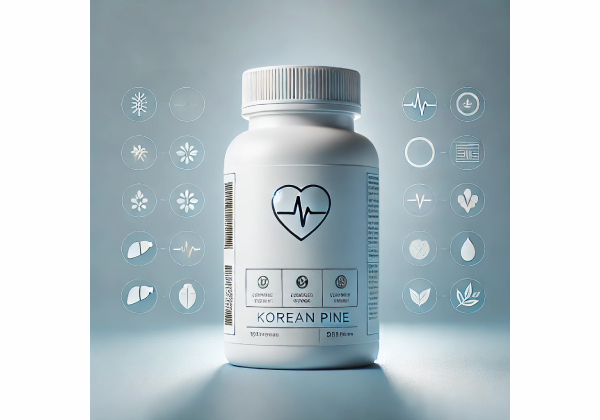
Korean pine (Pinus koraiensis) is best known for its rich, buttery nuts and the distinctive fatty acids in its oil—especially pinolenic acid and sciadonic acid. Beyond culinary appeal, extracts from the seed, oil, needles, and bark are explored for metabolic, lipid, and antioxidant effects. Early human studies suggest Korean pine nut oil may influence satiety hormones and appetite, while animal and cell work points to lipid-modulating and anti-inflammatory actions. At the same time, pine nuts are calorie-dense, allergic reactions are possible, and a rare taste disturbance called “pine mouth” has been linked to certain pine nut batches. This guide translates the science into clear, practical guidance: what Korean pine can and cannot do, how to choose among forms (oil, nuts, powder, capsules, tea), how much to use, and when to avoid it. You will also find dosage ranges anchored in real-world use, preparation steps, and troubleshooting tips to help you use Korean pine confidently and safely.
Essential Insights
- Korean pine nut oil may increase satiety and modestly reduce short-term food intake in some adults.
- Pinolenic and sciadonic acids are the signature fatty acids linked to appetite and lipid effects.
- Typical supplemental oil intakes range from 1,000–3,000 mg/day; whole nuts 10–30 g/day.
- “Pine mouth” is an uncommon, self-limited bitter/metallic taste disturbance after some pine nuts.
- Avoid if you have a tree-nut allergy, are pregnant without medical guidance, or take anticoagulants.
Table of Contents
- What is Korean pine and how it works
- Proven benefits and where it helps
- How to use Korean pine products
- Dosage: how much and when
- Safety, risks, and who should avoid
- Evidence: what research says
What is Korean pine and how it works
Korean pine (Pinus koraiensis) is a conifer native to Northeast Asia whose large seeds—marketed as pine nuts—are prized for flavor and nutrition. The kernels are rich in polyunsaturated fats, with a distinctive profile that includes pinolenic acid (18:3 Δ5,9,12) and sciadonic acid (20:3 Δ5,11,14), alongside linoleic acid (LA) and alpha-linolenic acid (ALA). These fats, together with plant sterols, tocopherols, and phenolics, underpin most of the proposed health effects.
Two mechanisms stand out:
- Satiety signaling. Fats in the small intestine can trigger gut-brain hormones such as cholecystokinin (CCK) and glucagon-like peptide-1 (GLP-1). Korean pine nut oil has been investigated for increasing these hormones, which can slow gastric emptying, reduce appetite, and lessen short-term energy intake. Effects, however, vary by dose, formulation (triglyceride vs. free fatty acid), meal timing, and individual response.
- Lipid and inflammatory modulation. Pinolenic and sciadonic acids belong to the less common Δ5-unsaturated fatty acids. In preclinical work, oils enriched with these fatty acids can influence hepatic lipid metabolism, apolipoprotein gene expression, and markers of adipogenesis. Korean pine needles and bark also contain terpenes and flavonoids with antioxidant activity, which may help counter oxidative stress after meals.
It is important to distinguish food use (eating whole nuts as part of meals) from supplement use (standardized oils, capsules, or extracts). Food use provides broader nutrients—protein, manganese, magnesium, vitamin E—while supplements deliver targeted fatty acids in precise milligram amounts. Both approaches can fit within a healthy pattern; the best choice depends on your goal (satiety support, lipid focus, culinary enjoyment) and your tolerance.
Finally, Korean pine is not the only source of pine nuts on the market. Species differ in fatty acid profiles, and mixed sourcing can affect both efficacy and side-effect profiles. Choosing a product that specifies Pinus koraiensis and provides third-party testing helps align expectations with outcomes.
Proven benefits and where it helps
Appetite and satiety. Short-term human trials using Korean pine nut oil (often marketed under branded names) have reported increased CCK and GLP-1 and reduced prospective food intake over subsequent hours. Benefits appear time- and dose-dependent, and findings are mixed across studies. Practically, people sometimes notice earlier fullness and smaller portions when oil is taken before a meal rich in protein and fiber. This is not a magic solution for weight loss, but it can be a supportive tool for portion control and snack reduction.
Postprandial comfort. By slowing gastric emptying slightly, satiety hormones may temper sharp hunger rebounds after meals. When combined with balanced meals (lean protein, non-starchy vegetables, intact grains), some users report fewer cravings later in the day. The effect is modest and individual; pairing pine nut oil with mindful eating yields the most consistent results.
Lipid profile nuance. In animal and mechanistic studies, Δ5-fatty acids from Korean pine seeds can influence lipoprotein metabolism. While strong human evidence for lowering LDL-C is limited, replacing refined carbohydrate or saturated fat calories with polyunsaturated-rich foods like pine nuts generally supports heart-healthy patterns. In daily life, using a small portion of pine nuts to replace bacon bits, processed croutons, or creamy spreads in salads can improve your meal’s fat quality.
Antioxidant support. Extracts from needles and bark show antioxidant and anti-inflammatory activity in cell and animal models and in early human work with leaf/needle preparations. For everyday eaters, the practical signal is simple: nuts are nutrient-dense whole foods with natural antioxidants that can complement a plant-forward pattern.
Culinary satisfaction and substitution. A benefit often overlooked: pine nuts add creamy richness that helps some people satisfy cravings with smaller portions. A tablespoon of lightly toasted Korean pine nuts folded into sautéed greens or sprinkled over soup can replace a larger amount of cheese or cream, trimming calories while maintaining mouthfeel.
Who it helps most. People aiming for appetite management within a broader weight-management plan; those improving dietary fat quality; home cooks who want richness without heavy sauces; and individuals assembling Mediterranean-style or plant-forward menus. It is not a stand-alone therapy for dyslipidemia or obesity.
What it does not do. Pine nut oil does not melt fat, detoxify the liver, or replace evidence-based treatments. Expect incremental, meal-level support rather than dramatic body-weight shifts.
How to use Korean pine products
Choose your form
- Whole nuts (kernels): Best for food-first approaches. Offer protein, minerals, vitamin E, and the signature fatty acids. Ideal for salads, pesto, roasted vegetables, grain bowls, and snacks.
- Oil (culinary): Delicate, nutty, best for finishing dishes. Avoid high-heat frying; use for drizzle or cold applications to preserve fatty acids.
- Softgels/capsules (standardized oil): Convenient for satiety experiments or when consistent dosing is desired. Look for Pinus koraiensis on the label, batch testing, and peroxide/anisidine values for freshness.
- Needle/leaf teas or extracts: Emerging area; products vary widely. If you try these for antioxidant support, choose reputable suppliers and start low.
Timing strategies
- For appetite support, take 30–60 minutes before a main meal. Some studies used premeal dosing to align fat sensing in the small intestine with mealtime CCK/GLP-1 release.
- If using whole nuts, incorporate 10–15 g into a starter (salad, soup) rather than the main course to shift fullness earlier.
- Evening use can help curb late-night snacking for some, but avoid very large portions close to bedtime if you experience reflux.
Culinary applications
- Toast lightly over low heat until just fragrant to enhance flavor without damaging fats.
- Blitz with basil, garlic, lemon, and olive oil for a pesto that uses fewer cheese calories.
- Sprinkle 1–2 tablespoons over roasted carrots, broccoli, or farro to add satiating richness.
- Create a yogurt-herb dressing and top with crushed pine nuts to replace heavy cream sauces.
Stacking with other habits
- Combine with protein (20–30 g/meal) and high-fiber sides (vegetables, legumes, intact grains) for more reliable satiety.
- Consider a pre-meal routine: hydration, a small salad with 10 g pine nuts, then the main course.
Storage and freshness
- Pine nuts and their oil are prone to oxidation. Store in an airtight container in the refrigerator; freeze for long-term storage. Smell and taste should be fresh and buttery—discard if bitter, metallic, or rancid.
- Buy small, frequent batches rather than bulk if you use them slowly.
Label literacy
- Prefer products that disclose botanical source (Pinus koraiensis), country of origin, harvest year, and third-party testing. Freshness metrics matter; low peroxides indicate less oxidation.
Dosage: how much and when
Food-use guidance (most people)
- Whole nuts: 10–30 g/day (about 1–3 tablespoons), integrated into meals. This provides taste satisfaction and the fatty acid profile without excessive calories.
- Culinary oil: 1–2 teaspoons (5–10 mL) as a finishing oil with salads, grains, or vegetables. Not a frying oil.
Supplement-use guidance (targeted satiety experiments)
- Standardized oil softgels: 1,000–3,000 mg/day, often divided before one or two main meals. Start at the low end for 1–2 weeks and monitor appetite, fullness, and any GI symptoms.
- Needle/leaf infusions/extracts: Because composition varies, begin with small servings (e.g., a weak tea once daily) and titrate cautiously, prioritizing reputable brands.
Dosing tips
- Pre-meal timing matters. Administer the oil 30–60 minutes before eating to better align with intestinal fat sensing and satiety hormone dynamics.
- Pair with fiber and protein. A pre-meal salad or broth plus protein in the main course tends to amplify fullness.
- Cycle and assess. Use for 2–4 weeks, then reassess. If no appetite or meal-size change is noticed, continuing may not be worthwhile for you.
- Mind the calories. Pine nuts are energy-dense (~180–200 kcal per 30 g). Keep portions modest if weight management is a goal.
Special contexts
- Athletes seeking energy-dense snacks can use higher food portions (30–40 g) within training calories, but supplemental oil rarely adds benefit beyond normal fueling.
- Plant-forward eaters can rotate with walnuts, almonds, or pumpkin seeds to diversify fats and micronutrients.
- Lipid-focused users should prioritize overall dietary patterns (more unsaturated fats, fewer refined carbs) rather than relying on pine nut oil alone.
When to stop or adjust
- New bitter/metallic taste within 1–3 days after eating pine nuts suggests “pine mouth.” Stop consumption; the taste usually resolves in days to weeks.
- GI discomfort, reflux, or nausea after oil dosing: lower the dose or switch to food-only use.
Safety, risks, and who should avoid
Common considerations
- Allergy: Pine nuts are tree nuts. Anyone with a nut allergy should avoid them unless cleared by an allergist. Cross-contact in facilities that process other nuts is common.
- Pine mouth syndrome (dysgeusia): An uncommon, self-limited bitter or metallic taste that develops hours to a few days after eating certain pine nuts and may last days to weeks. It is unpleasant but typically not harmful. Stop intake; hydrate, and use palate-cleansing foods until it resolves.
- Oxidation/rancidity: Stale nuts or oil can taste bitter and may upset the stomach. Refrigerate, use within shelf-life, and discard if flavor is off.
- Caloric density: Overuse can add calories quickly. Measure portions if weight is a concern.
Medication and condition interactions
- Anticoagulants/antiplatelets: Pine nuts are not a high-vitamin-K food, but oils and extracts may have mild effects on platelet function in theory. If you use warfarin, DOACs, or dual antiplatelet therapy, check with your clinician before starting a high-dose oil supplement.
- Diabetes therapies: Pre-meal oil may subtly affect appetite and timing of food intake. Coordinate dosing with your meal plan to avoid mismatches with medications that lower glucose.
- Pregnancy and lactation: Whole nuts as food are generally acceptable in typical culinary amounts unless allergic. For concentrated oils or leaf/needle extracts, consult a clinician before use due to limited safety data.
Quality pitfalls
- Species and sourcing: Mixed species in supply chains can alter fatty acid profiles and side-effect risk. Prefer products that clearly name Pinus koraiensis.
- Peroxide/anisidine values: Elevated oxidation markers signal poor freshness; reputable brands may publish these.
Red-flag symptoms (stop and seek care)
- Hives, swelling, wheezing, faintness after ingestion (possible anaphylaxis).
- Persistent vomiting or severe abdominal pain.
- Taste disturbance that persists beyond several weeks or is accompanied by other neurologic signs.
Who should avoid
- Anyone with known tree-nut allergy.
- Individuals with a history of pine mouth who are unwilling to risk recurrence.
- People on complex anticoagulation regimens without medical oversight.
- Those who cannot store nuts/oils properly (high heat/humidity) and thus face rancidity risks.
Evidence: what research says
Satiety and appetite hormones. Early controlled trials found that Korean pine nut oil increased CCK and GLP-1 and reduced short-term appetite in certain designs. Mechanistic in vitro work with human intestinal cells supports CCK release in response to pine nut fatty acids. However, not all studies replicate appetite reductions; some neutral trials highlight how dose, formulation (free fatty acid vs. triacylglycerol), meal composition, and participant characteristics shape outcomes. Net-net: there is biological plausibility with modest, variable clinical effects.
Body weight and lipids. Animal studies show reductions in adiposity and improvements in lipid markers with Korean pine oils or extracts, and cell models demonstrate anti-adipogenic effects. In humans, evidence for clinically meaningful LDL-C or weight loss changes remains limited. From a dietary standpoint, replacing saturated fat calories with polyunsaturated-rich nuts/oils is still a heart-healthy move, even if the effect is modest and gradual.
Antioxidant and metabolic extracts. Needle and leaf extracts have demonstrated antioxidative effects in small human and preclinical studies, and recent clinical exploratory work has examined postprandial lipoproteins. Product quality varies widely, so translating these findings into specific consumer doses requires caution.
Adverse effects and “pine mouth.” Case reports and small challenge trials document a transient dysgeusia beginning within 24–72 hours after eating certain pine nuts, resolving spontaneously. While the precise trigger is still debated (species, oxidation state, storage), the syndrome is self-limited. Importantly, it does not indicate heavy-metal toxicity. Buying fresh, well-labeled products and refrigerating them reduces risk.
Bottom line for consumers. Korean pine is a useful food and a promising, not definitive supplement for short-term appetite support. Expect small, habit-level benefits; prioritize overall dietary patterns, portion awareness, and consistent meal timing. Use nuts and oils for flavor and satiety, not as a stand-alone therapy.
References
- The effect of Korean pine nut oil on in vitro CCK release, on appetite sensations and on gut hormones in post-menopausal overweight women 2008 (RCT/mechanistic)
- No effects of Korean pine nut triacylglycerol on satiety and energy intake 2011 (RCT)
- Dietary supplementation with Korean pine nut oil: implications for appetite regulation and metabolic health 2021 (Review/clinical overview)
- Effects of Pinus pinaster and Pinus koraiensis seed oil on plasma lipoproteins and apolipoprotein gene expression in rats 1999 (Preclinical)
- A Trial Investigating the Symptoms Related to Pine Nut Ingestion: Pine Mouth Syndrome 2012 (Clinical investigation)
Disclaimer
This article is for educational purposes only and is not a substitute for personalized medical advice, diagnosis, or treatment. Always speak with a qualified healthcare professional about your health, nutrition, and medication questions, especially before starting any new supplement or making significant dietary changes. If you experience signs of an allergic reaction or persistent adverse effects after consuming pine nuts or related products, seek medical care promptly.
If you found this guide helpful, please consider sharing it with friends or colleagues on Facebook, X (formerly Twitter), or your preferred platform, and follow us for more evidence-based nutrition content. Your support helps us continue creating quality resources.










